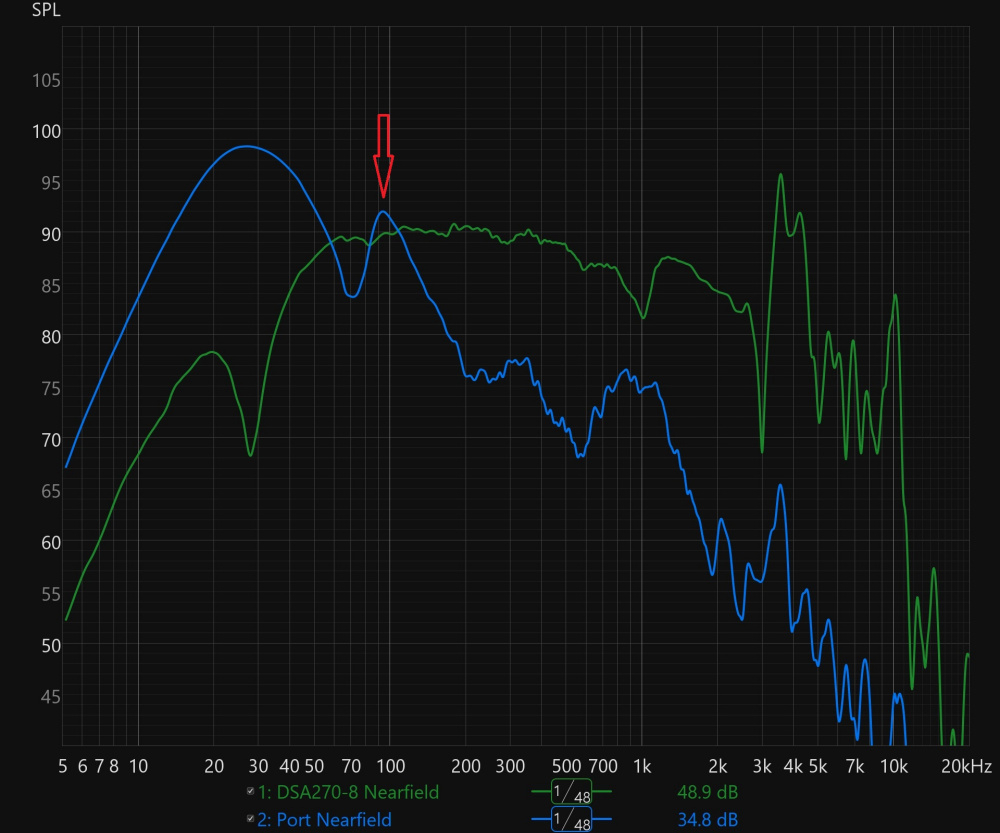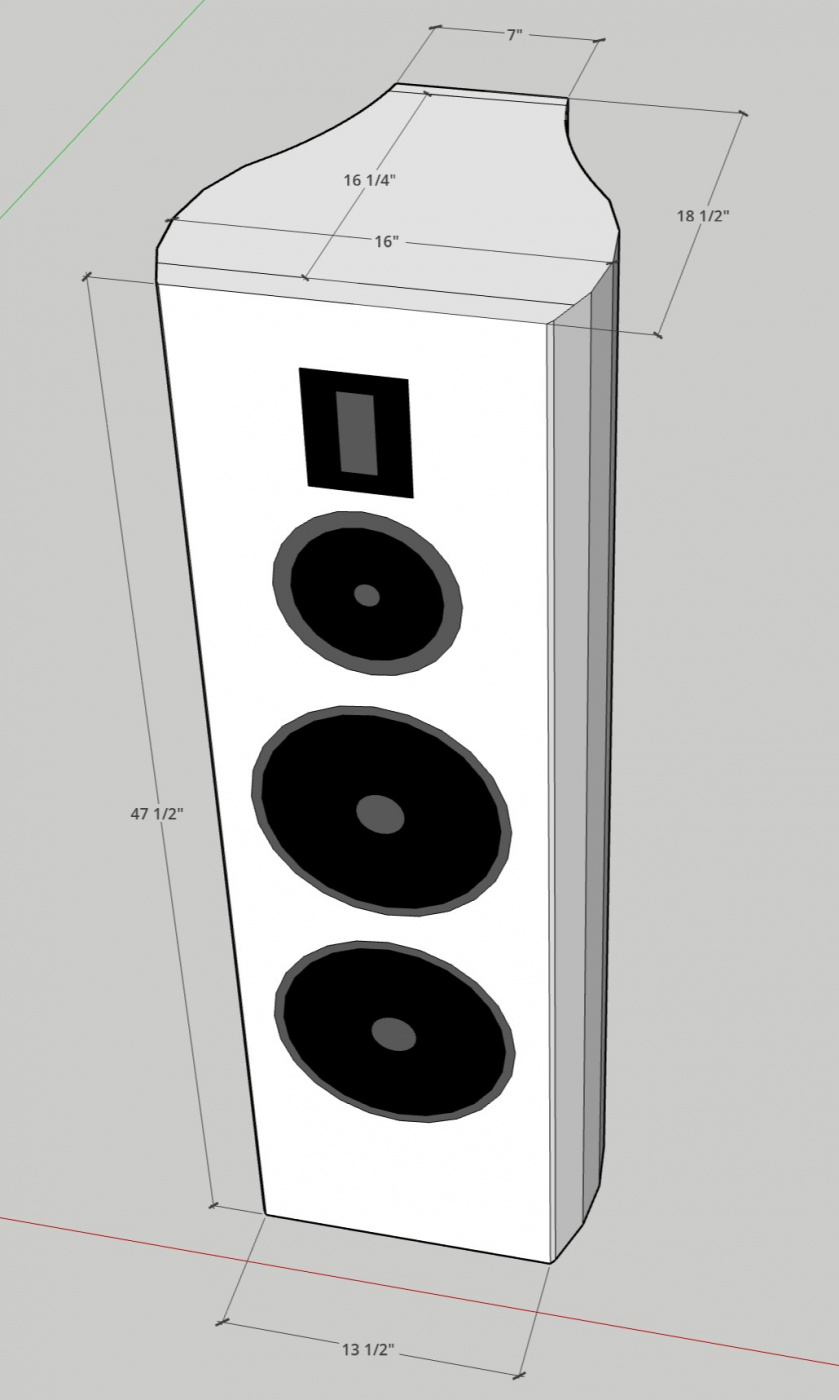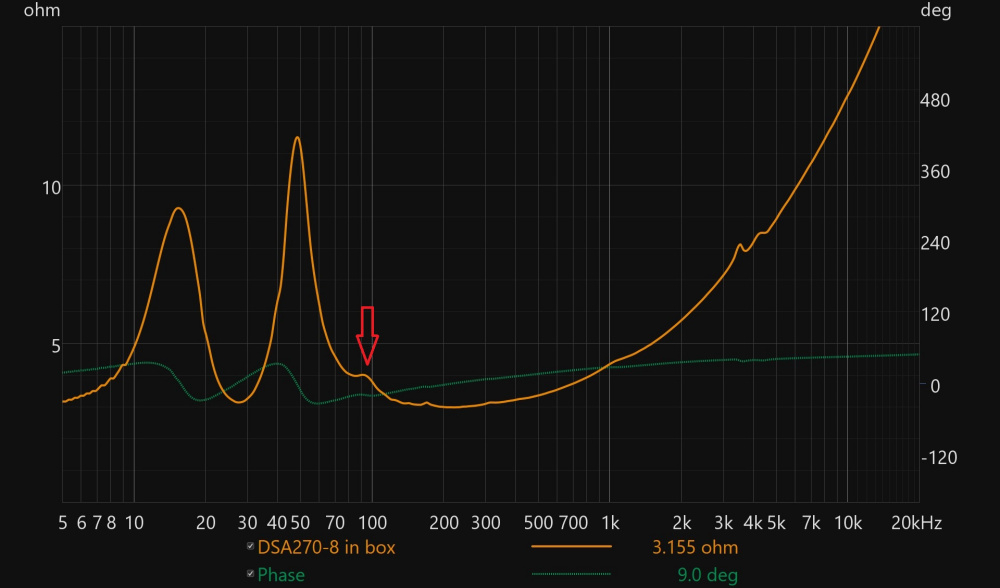Site Links
Howdy, Stranger!
It looks like you're new here. If you want to get involved, click one of these buttons!
Quick Links
Categories
In this Discussion
Who's Online (0)
What might cause this measured response?
What might cause this measured response?
In the image below are the nearfield responses of the woofer (green) and port (blue) in my large TMWW three-way that I took to SDC. There is a large peak at 95Hz in the nearfield of the port that when merged with the nearfield and farfield creates a large 4 dB in the overall response. Trying to think of what could be driving this...either something actually to do with the cabinet or possibly measurement error on my part.
- The internal dimensions of the speaker are 46" tall by 16-1/4" deep. The width varies as it is curved (about 12" at the front, widening to 14-1/2" and then narrowing to about 5-1/2" at that back, see image below).
- There is a midrange enclosure (not shown) with 2 to 4 inches of open space between the sides and back of the midrange enclosure and the cabinet walls, with 6 inches of space between the top of the midrange enclosure and the top of the speaker.
- All walls (except inside of front baffle) are lined with 2-inch Sonic Barrier insulation with some extra Dacron Batting added to the top and bottom (i.e., 2 inches of Sonic Barrier AND some Dacron batting in the top and bottom since I have a tall, skinny enclosure volume).
- The port is 11-1/4" from the bottom and directly behind the lower woofer. But there is a 2" dowel running vertically up the middle of the main enclosure and piece of 2-inch Sonic Barrier in the middle of the cabinet between the back of the woofer and the port opening.
- The port is 3" diameter and about 2" long with a large 1-1/2" roundover flare on the outside.
- The woofer and port were on a stand about 48 inches from the floor and 69 inches from the ceiling.
- Measurement was taken 1/4 inch from woofer and port, displayed with 200ms gating and 1/24th octave smoothing.
Some initial thoughts:
- The port length is very short so the port resonance is above 2 Khz
- The length of the wavelength for 95Hz is pretty huge so my first thought is that it is not cabinet related. BUT...see the inbox impedance curve below. There is no corresponding blip at 95 Hz in the free-air impedance and there is no peak in the actual woofer output, JUST the port.
I probably won't do much research to figure it out, but thought I'd ask here as the answer may be obvious to you more-experienced guys.




Comments
The valley roughly lines up with quarter wavelength (height). dunno specifically about the peak. Since there is an impedance peak I guess it would be some sort of other cabinet resonance?
That is approx 1/2 wavelength of the longest diagonal distance inside the enclosure. 13560/55 = 246 / 2 = 123Hz. Whenever I calculate these modes, they never come out exactly for some reason, but this is fairly close to 95Hz. Maybe the waves are bending around the midrange enclosure, which drops the peak to 95. Because this wavelength is so long, none of your 2" sonic barrier is able to dampen it.
Also, when you do near field port and woofer cone measurements, the gating should be turned off.
EDIT: Brain fart. 200ms gate effectively turns the gate off. So that is not it.
I have a build that did the same thing. My cabinet is the same height as yours. My peak was about 120 hz. I piled up about 10" of rockwool up at the bottom of the cabinet and also a bunch up top. It didn't completely clear it up but it helped a lot. My peak was higher than yours too. It was something like 5-6 db. In room response had a broad hump from 100-200 hz. After raising the speaker 5 inches off the ground, it was nice and flat. I don't know if the two were related or I had some floor bounce reinforcing that range, but that fixed it for me.
Could this be a reflection off the rear wall? Does the peek stay there off axis and at 3ft?
This makes perfect sense to me. I have experienced the same thing with multiple builds. Per Jeff Bagby's spreadsheet, the power response of a speaker, in the 100 to 200Hz region, will decrease as you raise the speaker off the ground.
Good to know!
Now that I have some confirmation that it is likely related to the interior cabinet height I will definitely attempt heavier stuffing at the top and bottom.
Hmmm...this got me thinking.
This is only in the nearfield of the port. The nearfield of the woofer does not show the same peak (i.e., the green line in the original post is quite smooth with no similar peak anywhere near 100Hz). That is a little odd to me.
Because nearfield is 1/4-inch away there really is no off-axis. I do have off-axis measurements 0 to 180 degrees, but they are at 1 meter so they are gated for reflections and I don't have useable data down to 100 Hz to see the spike. So when I get my measurement setup back up and working after Detroit I will try some measurements at 6, 12 and 18 inches, on and off-axis, and see if I can get an idea of what kind of stuff is showing up from the woofer and the port.
“I call for heavy stuffing at the bottom of the enclosure to reduce the lengthwise pressure node at 140Hz. Not doing so would cause some audible raggedness in the midbass. The difference between enough and not enough stuffing is easily seen in an impedance curve.”
John Krutke
http://zaphaudio.com/ZRT.html
Starkly absorptive damping is required for column resonance. The best thing would be rock wool in the extreme ends for absolution, and a column of dense damping sustained and held in the central core of the enclosure. An example would be a roll of Ultratouch around a core of long fiber wool or wool batting.
InDIYana Event Website
I have poplar dowels running up the middle of the enclosure for vertical bracing. I can wrap them with some wool and Ultratouch.
Do you think melamine foam (i.e., generic Magic Erasers) would do well in the ends? I have an unopened 100 pack. I have never used Rockwool but after looking it up I see Lowe's carries it, so I can do that if needed.
To be honest, while I think the melamine worked favorably in absorption, I think it's deadening properties are near zero. My Anomalies rang like a bell even with it installed. I had to add some wool batting to make up the difference.
InDIYana Event Website
If you are trying damping because you think it’s a standing wave, I would an actually suggest putting a sheet across a brace around the middle of the enclosure. Absorption of the standing waves is much more effective there than at the ends. You’ll need much more material at the ends to fix the issue.
Our 2-way towers had something similar and we used a single sheet of 1” denim over a brace to fix it.